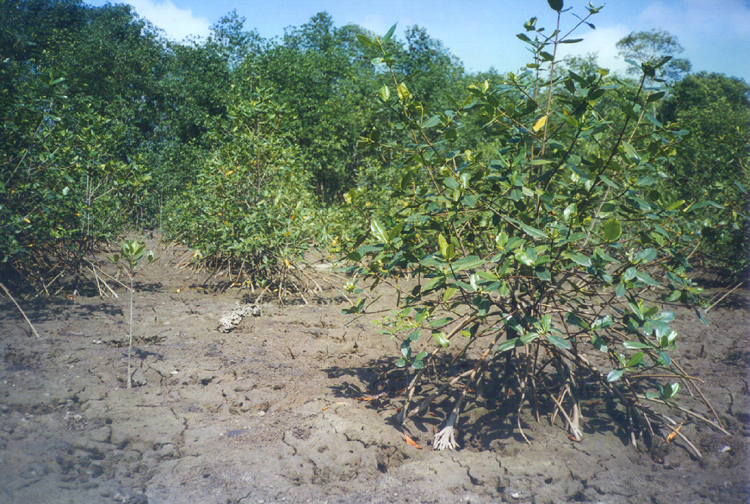Overview
This project of the Fundación de Defensa Ecológica (Ecological Protection Foundation – FUNDECOL) of Ecuador aimed to restore the mangroves of the Musine district in the Esmeraldas province of Ecuador. The project benefited the communities of traditional users who use the mangroves every day for the fish, mollusks, crustaceans, and timber that comprise the primary source of income and food for their families.
Indiscriminate cutting of trees in the mangroves, caused by the uncontrolled incursion of the shrimp industry in the Musine district, has resulted in the loss of vast areas of mangroves and created negative repercussions for other species that inhabit the ecosystem. Community efforts to protect the mangroves and active participation in reforestation, monitoring the conservation status of the ecosystem, and protection of the estuary has helped to restore the traditional link between people and mangroves and reaffirm their identity. The community took the initiative to participate in training sessions and reforestation, legislation, and community and environmental law workshops, and played a key role in the development and conservation of their own natural resources.
Quick Facts
Project Location:
Musine, Ecuador, 0.6116136999999999, -80.02065499999998
Geographic Region:
Latin America
Country or Territory:
Ecuador
Biome:
Coastal/Marine
Ecosystem:
Estuaries, Marshes & Mangroves
Area being restored:
13.28 hectares
Project Lead:
Fundación de Defensa Ecológica (Ecological Protection Foundation - FUNDECOL)
Organization Type:
NGO / Nonprofit Organization
Location
Project Stage:
Completed
Start Date:
2003-05-24
End Date:
2004-06-24
Primary Causes of Degradation
Fisheries & AquacultureDegradation Description
It is estimated that by 1999, the estuary of the Muisne River had lost some 90% of its original mangrove forest. The primary cause of this deforestation is the uncontrolled incursion of the shrimp industry into the region. This destruction of the mangrove forest has resulted in a loss of plant and animal species, frequent floods of residential and agricultural areas, and critical levels of poverty in the surrounding communities.
Reference Ecosystem Description
The mangrove estuary of Muisne River, in the Muisne district of southern Esmeraldas province, had an original extension of 20,098 hectares of mangroves, according to Ministerial Agreement Number 238 of the Ministry of Agriculture published in July of 1987.
Project Goals
– Reincorporate 32 acres (13 hectares) of abandoned shrimp ponds and degraded areas into the mangrove ecosystem, and reincorporate them into the ecosystem’s dynamics.
– Promote the sustainable management of mangroves among the local population by providing them with reforestation tools, and by the constant monitoring of the ecosystem’s conservation status.
– Provide training in legal matters related to the conservation of the mangrove ecosystem and citizen’s rights.
Monitoring
The project does not have a monitoring plan.
Stakeholders
Fundación de Defensa Ecológica (FUNDECOL) has been working for 14 years to defend, protect and restore the plants and animals of the mangrove ecosystem for the benefit of local user communities.
For the duration of this particular project, and especially during the first few months, meetings were held with various groups from the local communities–“Real Fortuna” from the town of Bilsa, “El Progreso” from the La Florida neighborhood, “Bellavista” from the Bellavista neighborhood, and “Mangrove Defense” from Daule, to offer a few examples. These meetings reaffirmed the need to restore the deforested areas, especially the abandoned shrimp ponds, as quickly as possible and reincorporate them into the local economy.
Description of Project Activities:
Once the areas for reforestation were established, the collection of red mangrove (Rhizophora mangle) and black mangrove (Avicennia Germinans) seeds began. By means of visits to the different estuaries, healthy propagules were collected, and then the healthiest were selected for later plantation in the nurseries.
Approximately 29,000 red and black mangrove seeds were collected in total, of which 27,500 were ultimately used in the replanting effort. The propagules were planted on 6.25 m² and 4 m² plots in ten distinct phases, with a total of 13.28 hectares of reforestation.
Ecological Outcomes Achieved
Eliminate existing threats to the ecosystem:
To date, the project has achieved a survival rate of 90% for the seedlings in the recovery areas.
Factors limiting recovery of the ecosystem:
There is a need for funding to further the restoration effort, especially funds to cover the cost of fuel.
Socio-Economic & Community Outcomes Achieved
Economic vitality and local livelihoods:
The participation of the mangrove's traditional users is growing, and they are beginning to make the decisions about the restoration, management, and use of the mangroves.
Long-Term Management
A team of ecosystem monitors was established from among members of the mangrove user group, and the hope is that they will come to understand the dynamics of the mangrove ecosystem. Toward this end, 20% of the replanted area was divided into five equal plots, and data about adaptability and growth, average survival rate, average growth per plantation, and average size of the plants was collected from these areas.
Furthermore, talks on constitutional law and legal provisions for the protection of the mangrove ecosystem have been implemented in local communities as part of this project. The mangrove users need to learn about their rights and about how to use the legal system to report any irregularities or violations in the newly created conservation policies.
Ultimately, the practitioners would like to have the 32 acres of mangrove that are under reforestation become part of an adjacent 9-acre wildlife reserve.
Sources and Amounts of Funding
18,925 USD Critical Ecosystem Partnership Fund (CEPF), United States; HIVOS (Agencia Humanística para el Desarrollo), Holanda/Netherlands; SWISSAID, Suiza
Other Resources
Fundación de Defensa Ecológica (FUNDECOL), Ecuador
Frank Navarrete P., Project Director
Email: [email protected]
Email 2: [email protected]
URL: http://www.fundecol.org/fundecol.php
Critical Ecosystem Partnership Fund (CEPF), United States
http://www.cepf.net/xp/cepf/index.xml



